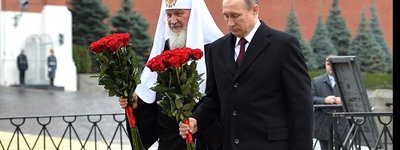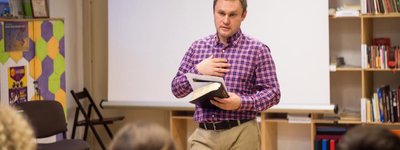Praying for Peace or Condoning a Crime?
If the priests from St. Petersburg truly wished to pray for peace, wouldn’t it have been more efficient to travel to Moscow and pray for peace before the Kremlin?
Recently, a group of priests from St. Petersburg organized a procession with the cross along portions of the front in the so-called Donbas and Luhansk People’s Republics (reported by Radio Liberty on 21 January 2017). Their avowed purpose was to pray for peace in the region. But in a television report aired on local stations, one of the priests, a Fr. Vladimir, compared the event to a procession that Ioasaph of Belgorod had planned in 1914, when the Mother of God told him in a dream to carry the icon of the Mother of God along the front lines of the Russian army so that it might achieve victory.
Perhaps Fr. Vladimir’s words were not reported accurately. For Ioasaph of Belgorod lived in the eighteenth century. Born in Pryluky, Ukraine in 1705, Ioakym Andriiovych Horlenko took the monastic name of Ioasaph. At that time, many learned Ukrainians filled the higher ranks of the Russian Orthodox Church. Appointed bishop of Belgorod in the Russian-Ukrainian border area in 1748, Ioasaph became famous for his piety, good works, and miracles. In 1754, the year of his death, Ioasaph was enthralled by a neglected icon of the Mother of God in a church in Izium (now in the Kharkiv region), which at his wish was transferred to a more prominent place. Later transferred along with the church to the nearby village of Pisky, whence it took the name of Mother of God of Pisky (in Russian, Peschanskaia), the icon became renowned for its miraculous powers. Meanwhile, the Trinity monastery cathedral at Belgorod became a center of pilgrimages and processions with the cross, all associated with the cult of Ioasaph.
In 1910, Tsar Nicholas II suggested that Bishop Ioasaph be canonized. His remains were examined, and in the following year the Holy Synod recognized him as a saint. About a year later, he is said to have appeared in a vision to an army colonel, warning him of terrible bloodshed to come if the people did not repent. When the First World War broke out, it is recounted that Saint Ioasaph appeared in simultaneous visions to the same officer and to an elder (starets) at Pisky, instructing them to have the icon of the Mother of God carried in a procession along the front lines in order to ensure victory. For some reason, the procession never took place. And Russia, as we know, eventually suffered massive defeats followed by revolution. Since 1991, the icon, kept at the cathedral in Izium, has been carried in various processions.
This report raises several questions. If the priests from St. Petersburg wanted to pray for peace, weren’t the front lines an odd place to do so? Did they actually try to deter the fighters of the Donetsk and Luhansk “People’s Republics” from attacking the Ukrainians? If so, they failed, as their procession was reportedly followed by a destructive barrage. Moreover, if they truly wished to pray for peace, wouldn’t it have been more efficient to travel to Moscow and pray for peace before the Kremlin? That, after all, is where the decisions on the war against Ukraine are made.
Fr. Vladimir’s implicit comparison of the war against Ukraine with the Great War is also questionable. In 1914, Russia and several other countries followed the rules of international relations and declared war on each other before sending out their armies. By and large, the rules of armed conflict were observed. Under those circumstances, it would have been understandable for the Russian Orthodox Church to support the troops with processions carrying crosses and icons. But Russia’s war that began a hundred years later has never been declared, and Russia even denies its involvement (though the St. Petersburg priests’ visit is evidence that it is very much involved). Not only is the war itself illegal, violating the Budapest Memorandum and basic principles of international law, but the manner in which it is being fought violates the Minsk accords. In short, it is a criminal enterprise. That priests from St. Petersburg should be involved in it is scandalous. Does their bishop know about this, and does he condone it? Perhaps someone should ask him.
As for Saint Ioasaph – his reaction to this clerical expedition, one imagines, would have been something like his words when he witnessed the disrespectful treatment of the icon of the Mother of God in Izium: “Forgive them their carelessness, for they do not know what they are doing.”
Or perhaps they know all too well.










